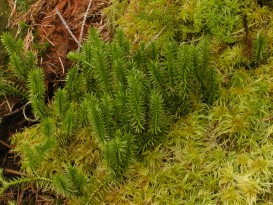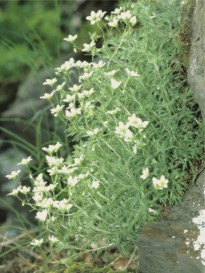Góry Stołowe - kraina zrodzona z morza
 Plants and mushrooms - for everybody interested
Plants and mushrooms - for everybody interested
Mushrooms
DVast areas of forests as well as very favourable moisture conditions make the mushrooms take a big part in the natural environment of the Stołowe Mountains. So far, they have not been fully explored. Nevertheless, it is known that most of the large- fructification fungi can be found in the Park's forests, including cep mushroom, golden boletus, yellow-cracked boletus, rough-stalked boletus, honey mushroom, fly agaric and delicious lactarius. Among less popular species, umbrella mushroom can be found in woodland clearings and drier meadows close to the woods, and little yellow mushroom called Hygrophorus hypothejus in wet grassy communities. Dead trees are attacked by bracket fungi, including common bracket fungus often found on beech-tree trunks. Of the rare species under full protection in Poland, the following need to be mentioned: crested sparassis, giant puffball, stinkhorn, and Hericium coralloides.
been fully explored. Nevertheless, it is known that most of the large- fructification fungi can be found in the Park's forests, including cep mushroom, golden boletus, yellow-cracked boletus, rough-stalked boletus, honey mushroom, fly agaric and delicious lactarius. Among less popular species, umbrella mushroom can be found in woodland clearings and drier meadows close to the woods, and little yellow mushroom called Hygrophorus hypothejus in wet grassy communities. Dead trees are attacked by bracket fungi, including common bracket fungus often found on beech-tree trunks. Of the rare species under full protection in Poland, the following need to be mentioned: crested sparassis, giant puffball, stinkhorn, and Hericium coralloides.
Cryptogamous plants and rock vegetation
Cryptogamous plants are present in great quantities in the area of the Stołowe Mountains National Park. This is owing to an exceptional geological structure, plentiful quantities of open rock surfaces, diversified relief, and humid climate, which is most favourable for theses plant species. Water is retained on the impermeable bedrock within mudstones and marls of the middle planation, permitting plenty of humid habitats - bog-springs and peat bogs. Microclimatic conditions are also of great importance, particularly for rock vegetation of blue-green algae, liverworts and mosses, especially in the zone of upper joint sandstones. These rocks thanks to their ability to soak water in the area of high precipitation have further impact on retention of considerably high air humidity. A particularly humid microclimate can be found in rock fissures and rifts, owing to the occurrence of colder air, slow evaporation and much later snow-melting. The so-called "rooting stalagmites" is an interesting ecosystem that develops in the microclimate of rifts and semi-caves of sandstone rocks. They are built in places where a young tree (e.g. beech-tree) root growing near the soil surface is exposed to constantly dripping water from a cave's roof or rock overhang. A thick tangle of tiny roots is gradually built upwards in the air environment in the direction of the dripping water. The tangle is densely intertwined with mycorrhizal hyphae. Its inhabitants also include liverworts, algae, blue-green algae, and a number of invertebrates (springtails, tiny coleopterons, ants) feeding on the root excretion and hypha, and their predators - mostly spiders. The "rooting stalagmites" can grow as large as 10 or even 50 cm in height with a diameter ranging from a few to dozen centimetres, depending on the intensity of dripping water. When reaching a semi-cave's roof, they sometimes form the so-called "rooting columns". As the Stołowe Mountains are the only region in Poland with such an abundance of joint sandstones, the relevant rock vegetation is also exceptional. Among other things, it features a wealth of liverwort species. This primitive bryophyte group requires higher air humidity than mosses do. The liverworts are clearly distinguished from mosses. They have considerably less differentiation in tissue, and their body may often be a thallus. The reproduction organs of liverworts are also shaped differently. An example of this group of plants can be pleszanka (shown in illustration) three species of which can be found in the area of the Stołowe Mountains National Park. Among over 120 taxons of liverworts found here, at least 5 do not occur in any other stands in Poland, and a number of them are considered very rare species throughout the country. One of them, Gymnocolea acutiloba, considered a relic survived from the Tertiary Period, flourishes on the crevice walls in Szczeliniec Wielki. The liverworts found in the Park are mostly mountain species many of which occur here well below the elevations reached in other mountain ranges. It also applies to mosses, among which 86 out of 224 confirmed species are mountain species, including 13 alpine species. Among the mosses flourishing in the Park area that deserve particular attention, there are one endemic species Dicranum sendtneri, one new for Poland, and four new species for the Sudety. The occurrence of świetlanka moss in the rifts of Szczeliniec is of particular interest. A filament germinating from the spore of this plant creates large ball cells that reflect light, that is why this moss glows greenish in the dark crevices. Modrzaczek is a very decorative species often found on rocks and in humid spruce forests. It has highly hygroscopic leaves thanks to the special cells which absorb water. Despite the considerably small area of the Stołowe
evaporation and much later snow-melting. The so-called "rooting stalagmites" is an interesting ecosystem that develops in the microclimate of rifts and semi-caves of sandstone rocks. They are built in places where a young tree (e.g. beech-tree) root growing near the soil surface is exposed to constantly dripping water from a cave's roof or rock overhang. A thick tangle of tiny roots is gradually built upwards in the air environment in the direction of the dripping water. The tangle is densely intertwined with mycorrhizal hyphae. Its inhabitants also include liverworts, algae, blue-green algae, and a number of invertebrates (springtails, tiny coleopterons, ants) feeding on the root excretion and hypha, and their predators - mostly spiders. The "rooting stalagmites" can grow as large as 10 or even 50 cm in height with a diameter ranging from a few to dozen centimetres, depending on the intensity of dripping water. When reaching a semi-cave's roof, they sometimes form the so-called "rooting columns". As the Stołowe Mountains are the only region in Poland with such an abundance of joint sandstones, the relevant rock vegetation is also exceptional. Among other things, it features a wealth of liverwort species. This primitive bryophyte group requires higher air humidity than mosses do. The liverworts are clearly distinguished from mosses. They have considerably less differentiation in tissue, and their body may often be a thallus. The reproduction organs of liverworts are also shaped differently. An example of this group of plants can be pleszanka (shown in illustration) three species of which can be found in the area of the Stołowe Mountains National Park. Among over 120 taxons of liverworts found here, at least 5 do not occur in any other stands in Poland, and a number of them are considered very rare species throughout the country. One of them, Gymnocolea acutiloba, considered a relic survived from the Tertiary Period, flourishes on the crevice walls in Szczeliniec Wielki. The liverworts found in the Park are mostly mountain species many of which occur here well below the elevations reached in other mountain ranges. It also applies to mosses, among which 86 out of 224 confirmed species are mountain species, including 13 alpine species. Among the mosses flourishing in the Park area that deserve particular attention, there are one endemic species Dicranum sendtneri, one new for Poland, and four new species for the Sudety. The occurrence of świetlanka moss in the rifts of Szczeliniec is of particular interest. A filament germinating from the spore of this plant creates large ball cells that reflect light, that is why this moss glows greenish in the dark crevices. Modrzaczek is a very decorative species often found on rocks and in humid spruce forests. It has highly hygroscopic leaves thanks to the special cells which absorb water. Despite the considerably small area of the Stołowe Mountains and low altitude, a large number of valuable forms, varieties and species of lichens also grow here. In the treatise by Tobolewski dated 40 years back, 214 taxons were specified, including endemic subspecies and varieties, 2 new taxons for the science, 3 new species for Poland, and many alpine species that grow in the Stołowe Mountains on exceptionally low altitude. However, those data require verification due to the considerable increase in air pollution that as we know the lichens are very sensitive to, and the devastation of many natural stands, the more so because some of the species on the above-mentioned list were single-stand species. Cryptogams usually take major part in the development of rock vegetation. The most interesting plant associations within the Stołowe Mountains National Park were developed on the natural exposures of marl rocks containing limestone. Bryophyte species are predominant, and communities with participation of ferns and flowering plants also appear in the next stages of succession. Among the ferns, the suboceanic species can be found such as: green spleenwort (Asplenium viride), Asplenium trichomanes, Cystopteris fragilis, as well as the mountain species such as Polystychum aculeatum. Among the flowering plants, Saxifraga can be found in one of these plant associations - a real rarity in the Park's flora. This white-flowering plant hanging from the rock benches grows only in one stand in the Stołowe Mountains, which is also the only stand in Poland. It is included in the Polish Red Book of Plants, being also a rare species in Europe. Another noteworthy higher plant that occurs in this community is Cardaminopsis arenosa, very rare in the flora of our country.
Mountains and low altitude, a large number of valuable forms, varieties and species of lichens also grow here. In the treatise by Tobolewski dated 40 years back, 214 taxons were specified, including endemic subspecies and varieties, 2 new taxons for the science, 3 new species for Poland, and many alpine species that grow in the Stołowe Mountains on exceptionally low altitude. However, those data require verification due to the considerable increase in air pollution that as we know the lichens are very sensitive to, and the devastation of many natural stands, the more so because some of the species on the above-mentioned list were single-stand species. Cryptogams usually take major part in the development of rock vegetation. The most interesting plant associations within the Stołowe Mountains National Park were developed on the natural exposures of marl rocks containing limestone. Bryophyte species are predominant, and communities with participation of ferns and flowering plants also appear in the next stages of succession. Among the ferns, the suboceanic species can be found such as: green spleenwort (Asplenium viride), Asplenium trichomanes, Cystopteris fragilis, as well as the mountain species such as Polystychum aculeatum. Among the flowering plants, Saxifraga can be found in one of these plant associations - a real rarity in the Park's flora. This white-flowering plant hanging from the rock benches grows only in one stand in the Stołowe Mountains, which is also the only stand in Poland. It is included in the Polish Red Book of Plants, being also a rare species in Europe. Another noteworthy higher plant that occurs in this community is Cardaminopsis arenosa, very rare in the flora of our country.
Do you want to know more? Choose the topic
Park Narodowy Gór Stołowych
ul. Słoneczna 31
57-350 Kudowa Zdrój
tel. +48 74/ 8661-436, +48 74/ 8662-097
fax. +48 74/ 8654-918
pngs@pngs.com.pl
Copyright by Park Narodowy Gór Stołowych
